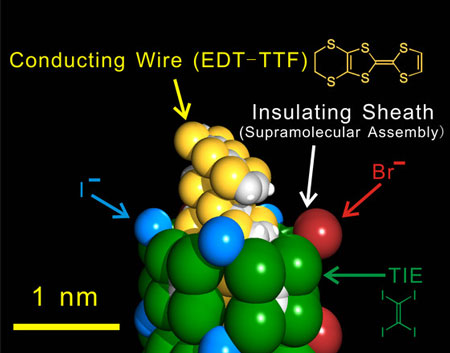| Posted: May 9, 2008 |
Molecular cables get insulating sheath |
|
(Nanowerk News) Japanese scientists have developed a range of insulating materials that should allow computer circuits to be built from nanowires that are tens of thousands of times thinner than a human hair.
|
|
The strategy could help to pack much more processing power into the computers of tomorrow—not least because it would allow conventional, two-dimensional circuit boards to expand into the third dimension.
|
|
Scientists have already shown that nanowires can be connected together to make logic circuits that perform simple calculations. But the bare wires are prone to short-circuits. Like any electrical cable, they operate much better if they are insulated by a non-conducting material.
|
|
Now, Hiroshi Yamamoto, Reizo Kato and colleagues of RIKEN’s Advanced Science Institute, formerly the Discovery Research Institute, Wako, along with several other Japanese research centers, have created molecular-scale insulating sheaths for nanowires ("Supramolecular Insulating Networks Sheathing Conducting Nanowires Based on Organic Radical Cations").
|
 |
| The conducting nanowire is sheathed in insulating molecules containing bromine and iodine. (Image: RIKEN)
|
|
The team created different examples of conducting nanowires based on stacks of molecules called tetrathiafulvalenes (TTFs). Their arrangement of carbon, hydrogen and sulfur atoms means that under certain conditions electrons can travel easily from one molecule to the next, so that a current flows through the wire. The properties of the wire can be fine-tuned by using similar molecules that contain selenium instead of sulfur.
|
|
In one such example, called (TSF)Cl(HFTIEB), a selenium-based conducting wire is surrounded by a relatively thick layer of molecules that incorporate iodine and fluorine atoms. This barrier—just one billionth of a meter thick—has a resistance some 100 million times greater than the wire it protects. This is the highest difference in resistivity within a single chemical substance ever recorded and comparable to the insulating power of epoxy resin, the scientists say, suggesting that HFTIEB provides good insulation for molecular conducting wires.
|
|
One of the most exciting parts of the scientists’ technique is that these insulated wires ‘self-assemble’, spontaneously growing into the desired arrangement from their component parts. In the latter case, iodine is a crucial linchpin in holding the wire together.
|
|
All the examples created by the team were simple one-dimensional wires. However, it should be possible to achieve similar results using molecules that tend to grow into two- and three-dimensional networks. “Nanoscale wiring in 3D space could potentially realize very high-density and large-scale memory or logic circuits in the near future,” the scientists say.
|
|
The next important challenges include reducing the number of molecular defects in the wires, and developing thicker, higher-resistance sheathing.
|

